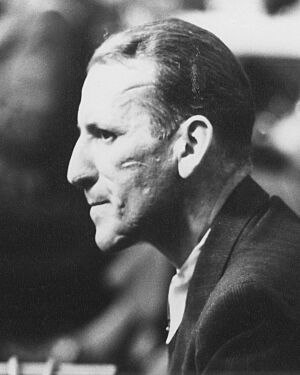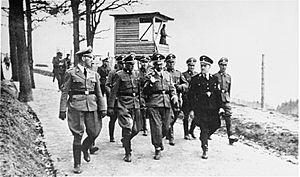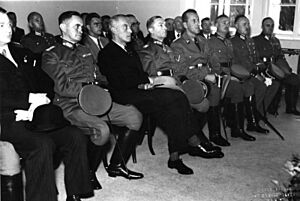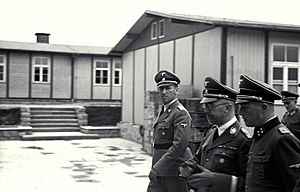Ernst Kaltenbrunner facts for kids
Quick facts for kids
Ernst Kaltenbrunner
|
|
|---|---|

Kaltenbrunner during the Nuremberg trials (1945)
|
|
| Born |
Ernst Kaltenbrunner
4 October 1903 Ried im Innkreis, Austria-Hungary
|
| Died | 16 October 1946 (aged 43) |
| Nationality | Austrian |
| Alma mater | University of Graz |
| Known for |
|
| Political party | Nazi Party (NSDAP) |
| Spouse(s) |
Elisabeth Eder
(m. 1934) |
| Partner(s) | Gisela Gräfin von Westarp |
| Children | 5 |
| Conviction(s) | Crimes against humanity |
| Criminal penalty | Execution by hanging |
| SS service | |
| Allegiance | |
| Service/ |
|
| Years of service | 1931–1945 |
| Rank | Obergruppenführer |
Ernst Kaltenbrunner (born October 4, 1903 – died October 16, 1946) was a very high-ranking official in the SS, a powerful organization in Nazi Germany. He played a significant role in the terrible events of World War II and the Holocaust.
Early Life and Education

Ernst Kaltenbrunner was born in a town called Ried im Innkreis, Austria. His father was a lawyer. Ernst spent his early years and went to primary school in Raab, and later attended a high school in Linz.
His family had strong nationalist beliefs. As a child, he was friends with Adolf Eichmann, another SS officer who was deeply involved in the Nazis' plans to harm Jewish people. After high school, Kaltenbrunner studied law at Graz University and earned his PhD in 1926.
He worked at a law firm in Salzburg for a year. Then, he opened his own law office in Linz. Kaltenbrunner had noticeable scars on his face. Some say these came from dueling during his student days, while others believe they were from a car accident.
In 1934, Kaltenbrunner married Elisabeth Eder, who was also a member of the Nazi Party. They had three children together. He also had twins, Ursula and Wolfgang, born in 1945, with Gisela Gräfin von Westarp. All of his children survived the war.
Rise to Power in the Nazi Regime
Kaltenbrunner joined the Nazi Party in 1930 and the SS in 1931. By 1935, he was seen as an important leader within the Austrian SS. In 1938, he helped with the Anschluss, which was when Nazi Germany took control of Austria. After this, he was put in charge of the SS and police forces in Austria.
In January 1943, Kaltenbrunner became the chief of the Reich Security Main Office (RSHA). This was a very powerful office that controlled several security and police groups, including the Gestapo (secret police). He took over this role after Reinhard Heydrich, the previous chief, was killed in 1942.
Role in World War II
Kaltenbrunner was strongly against Jewish people. Under his leadership, the Nazis' terrible actions against many groups, especially Jewish people, became even more intense. He helped organize the security and police groups that were involved in widespread persecution. This included stopping resistance movements in areas Germany had taken over, making many arrests, and sending people to their deaths.
After World War II ended, Kaltenbrunner was the highest-ranking SS member to be put on trial. This trial was held at the Nuremberg trials, where important Nazi leaders were judged for their actions during the war. He was found responsible for war crimes and crimes against humanity. Kaltenbrunner was sentenced to death and was executed on October 16, 1946.
See also
 In Spanish: Ernst Kaltenbrunner para niños
In Spanish: Ernst Kaltenbrunner para niños




